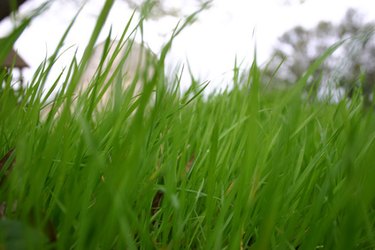
Georgia yards are plagued with weeds all year long. Winter weeds grow in the fall and stick around until spring. Summer weeds start popping up in the spring and last until the fall. Pre-emergence herbicides work well to prevent weeds. When applied in the fall, they keep springtime germination of weeds at bay; winter applications keep summer weeds down. For homeowners who want a simpler solution and one that feeds their lawn, use a weed-and-feed combination.
Considerations
Video of the Day
Weed-and-feed mixtures may be convenient but it's challenging to determine when to apply them. According to the University of Georgia College of Agricultural and Environmental Sciences, several factors must be considered when using them. Turf grasses have different needs and must be fertilized at certain times of the year. This may not coincide with the best times to apply weed killer. However, with combination products, everything is applied at once. The mixtures should also be used with caution around certain plants like ornamental plants and bushes. Weed-and-feed mixtures can severely injure the roots.
Video of the Day
Time Frame
Weed control in Georgia should begin in February to catch the weeds in their germination period. Fertilization typically begins in April. The timing doesn't match up. Experts with the University of Georgia College of Agricultural and Environmental Sciences recommend using separate fertilizer and weed control. However, if you want to use one product, apply it around April 1.
Ingredients
It is essential when using weed-and-feed to determine if the suggested rate gives the lawn enough of what it needs. The fertilizer rate must match up with the turf grass' demands for best and healthiest growth. In addition, the amount of herbicide must be sufficient to kill the weeds that tend to grow in your yard. If the weed-and-feed doesn't have enough of both chemical components, you may need to apply more herbicide or fertilizer at another time.
Methods
In addition to weed-and-feed, mowing and hand pulling (or hoeing) will keep annual and biennial weeds at bay. Manual weed control works well on smaller yards but not as well on perennial weeds. As long as the roots are pulled out, the weeds will not immediately grow back. Mowing the yard to the appropriate height for your turf grass will control weeds. Mowing cuts back on food reserves and keeps the seeds from maturing. St. Augustine grass is the shortest and should be mowed to .5 to 2 inches, buffalo grass and blue grama should be mowed to a height of 1 to 2 inches, carpetgrass and centipede grass to 1.5 to 2.5 inches, and Bahia grass can be longer, kept at about 2 to 4 inches.